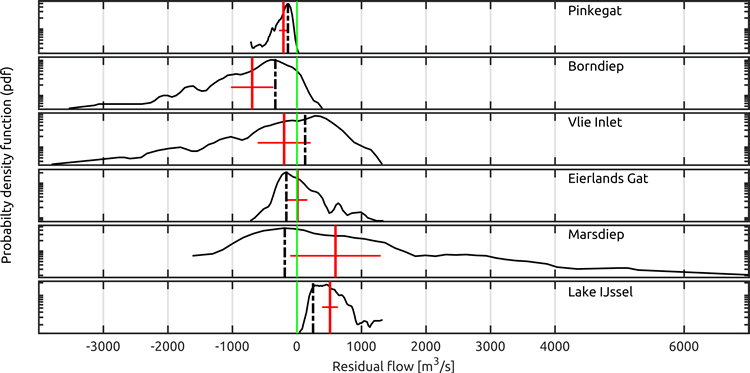U. Gräwe
Leibniz-Institute for Baltic Sea Research,
Introduction
The western Dutch Wadden Sea (wDWS) is a region of intertidal flats located between the chain of Wadden Islands and the Dutch mainland. The residual circulation in the wDWS has been previously studied through numerical simulations, measurements, and analytical models. However, all three methods are far from perfect. The analytical models are limited due to their implied assumptions. Numerical model investigations lack sufficient spatial resolution or time coverage. The measurements (for instance in the Marsdiep Inlet) are challenged by the high level of uncertainty due to the needed post processing to convert ADCP measurements into volume fluxes. In this study, I conducted a numerical hindcast covering the period 1979-2018. This will allow studying the monthly and annual variability of the residual water exchange in wDWS in a consistent fashion.
Methods
All results are obtained from three-dimensional numerical simulations carried out with the General Estuarine Transport Model (GETM), at a horizontal resolution of 200m and with terrain-following vertical adaptive coordinates with 25 layers. The setup is nearly identical to the one of Duran.Matute et al. 2014. The model run covers the period 1979-2018. The data analysis is based on 20 minutes snapshots of transects over the inlets and watersheds.
Results

Figure 1 Probability density functions of monthly residual flows through selected tidal inlets. Positive flow indicates a transport into the Wadden Sea. The vertical red line marks the mean value; the black dashed-dotted line the median. The horizontal red line indicates the standard deviation. The analysis is done for the period 1979-2018.
The analysis of the monthly residual flow through selected tidal inlets indicates that the average flow through the Marsdiep is positive (Figure 1). Thus, the residual flow points into the direction of the Wadden Sea. The other inlets show a net export of water volume. Whereas the average flow varies between -500 and +500 m³/s, especially Marsdiep, Vlie Inlet and Borndiep can show monthly residual flows exceeding the ten-fold of the mean. Moreover, all three inlets show a pronounced skew distribution.
Duran-Matute, M., Gerkema, T., de Boer, G. J., Nauw, J. J. & Gräwe, U. Residual circulation and freshwater transport in the Dutch Wadden Sea: a numerical modelling study. Ocean Sci. 10, 611–632 (2014).
I. Surname1*, F.N. Another-Surname2 , Y. Next-Surname2
1 University Name, Country; 2 Organization Name, Country
* Corresponding author: mail.name@organization.org


